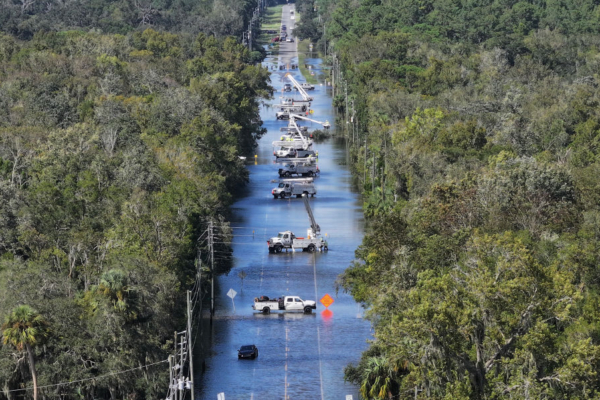On Monday (September 30), Hurricane “Helene” and the historic flooding it caused ravaged the southeastern United States, resulting in at least 100 deaths and leaving over 2 million households and businesses without power.
“Hurricane “Helene” has become one of the deadliest hurricanes to hit the continental United States in the past 50 years. Since making landfall in the Big Bend area of Florida last Thursday (September 26) evening, “Helene” has swept through Florida, Georgia, North Carolina, South Carolina, Tennessee, and Virginia, bringing strong winds, heavy rains, and flooding.
Atlanta received over 11 inches of rain within 48 hours, breaking records dating back nearly 150 years. Western North Carolina suffered devastating rainfall, with some areas receiving over 30 inches. Homes were washed away, bridges collapsed, semi-trucks were blown into heaps, while mud, debris, and store goods were washed onto the streets by the floods.
So far, the six states mentioned above have reported a death toll of 115 due to the hurricane.
Buncombe County in North Carolina confirmed the death toll has risen to 35 people, with expectations for further casualties. Authorities have received about 600 missing persons reports, but anticipate many missing individuals will be confirmed safe once communication is restored.
Currently, critical infrastructure has been damaged. Many roads remain closed on Monday, with unstable cellphone signals. People may find it difficult to contact relatives and friends for help in the days following the storm.
County Executive Avril Pinder stated, “We have no water, most areas in the county are without power. Road conditions are still very dangerous.”
She mentioned that on Monday morning, three trailers filled with water arrived, but it was only enough to provide each resident with one day’s worth of water.
North Carolina Governor Roy Cooper and Federal Emergency Management Agency Director Deanne Criswell visited the county on Monday to assess the situation.
Pinder informed CNN that they would be conveying the urgent need for water to the two senior officials.
“We have been requesting water, we have now just gotten water, and the amount is still very low,” she said. “Our community has huge needs, and we hope to see the state government make a different response, make a better response.”
Reportedly, a deputy sheriff from the county died. So far, North Carolina has confirmed three officers sacrificed their lives during hurricane rescue operations.
Mayor Esther Manheimer of Asheville town in North Carolina remarked in a television interview on Monday morning, “Nobody knew or anticipated the extent of the destruction here. Neighbors are helping each other.” She noted residents were sharing water and taking care of one another.
Henderson County spokesperson Mike Morgan mentioned, “This is a mountainous area, so we have rescue teams hiking up to every household, taking people to helicopters, then the rescue teams hike back down and head out again.”
“Some towns are just gone,” he added.
Authorities in North Carolina stated that search and rescue teams are traversing the mountains to find survivors, with some towns being completely demolished by this most devastating and deadliest hurricane in recent years.
Cooper has mobilized over 500 National Guard soldiers and pilots for disaster relief. Additionally, more than 200 vehicles and aircraft, including cranes, emergency aviation assets, and high-water vehicles, are working tirelessly to save lives.
“This is an unprecedented storm that requires unprecedented response,” he stated on CNN, mentioning that relief teams are airlifting supplies to areas unreachable by land.
President Biden assured the disaster-stricken communities that “the federal government stands with you,” and aid is on its way.
“We will continue to provide resources, including food, water, communication, and lifesaving equipment,” Biden said in a press conference on Monday, “until the job is done.”
Vice President Harris expressed her plans to visit the disaster area as soon as possible without disrupting rescue and recovery operations.
Former President Trump arrived in the affected area of Georgia on Monday, delivering a speech and helping distribute relief supplies.
AccuWeather has raised its total estimated losses and economic damages caused by Hurricane “Helene” to $145 billion to $160 billion. The meteorological department stated “Helene” is expected to be one of the most financially devastating storms in U.S. history, due to the significant storm surges, strong winds, and flooding it brought.
Currently, the most deadly hurricane in the United States was Category 5 Hurricane “Katrina” in August 2005, causing at least 1,833 deaths from the storm and flooding. Hurricane “Ian,” which struck the southeastern part of Florida in 2022, resulted in 150 direct and indirect fatalities.
At present, Hurricane “Helene” ranks third on the list, surpassing Hurricane “Irma” in 2017, which caused 92 deaths in the United States, most of them in Florida.
Superstorm “Sandy” in 2012 and Hurricane “Harvey” in 2017 resulted in 60-75 deaths in the United States.

